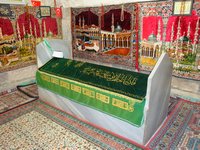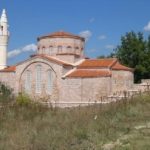Sinan in Thrace Population: 125,500
Old name: Arcadiopolis (Roman)
Heading from İstanbul to Edirne you might want to pause to take a look at Lüleburgaz. Even though only slight remains of Arcadiopolis survive there is also a little-visited Sinan mosque here too.
In 1912 the surrounding area was the setting for the Battle of Lüleburgaz between the Bulgarians and the troop of the Ottoman Empire during the First Balkan War. Despite being greatly outnumbered the Bulgarians managed to inflict a significant defeat on the Ottomans. It was the most important battle between the end of the Franco-Prussian War (1870-71) and the start of the First World War in 1914.
Around town
Lüleburgaz has not been quite as cavalier about its past as nearby Çorlu and the town centre is dominated by the vast Sokollu Mehmet Paşa mosque complex built by Sinan between 1569 and 1571.
Born in Visegrad in what is now Bosnia, Sokollu Mehmet Paşa was taken as a young man to be trained as a janissary but rose through the ranks of the Ottoman bureaucracy and ended up serving as grand vizier to sultans Süleyman the Magnificent, Selim II and Murad III, until he was assassinated in 1579. He’s buried in a tomb designed for him by Sinan in Eyüp in İstanbul.
The külliye in Lüleburgaz is of extraordinary size, its centrepiece a mosque that is approached via a portico (unfortunately glassed-in), which continues around all three remaining sides of the courtyard to provide a perfect place for people to stroll and study. Right in the middle of the courtyard is an elegant şadırvan (ablutions fountain) to which a wavy roof with pretty paintings was added in the 18th century.
Facing the mosque is a gateway that leads to an arasta (shopping arcade) which, unusually, has a domed arch straddling it. The tiny shops are still in use today, some of them selling devices such as mobile phones that would have had Sinan scratching his head, others such as the Kübbeleraltı Balık Evi (“Under the Domes Fish House”) dishing up enjoyable meals to local workers in historic surroundings.

The complex continues across the road to encompass a double-domed hamam that now stands sadly redundant.
If you walk around the walls you will pass a türbe (tomb), which now serves as the headquarters for the local branch of Kızılay (the Red Crescent), and a long stretch of wall, which must once have provided the back for the rooms of the students studying at the medrese (seminary). The crumbling brickwork is dotted with the remains of fireplaces, a reminder of the 17th-century Ottoman travel writer, Evliya Çelebi,, who claimed that he had counted 150 fireplaces in the complex.
Easier to miss is the much smaller Zindan Baba Türbesi housed in a domed tower beside the Hükümet Konağı (Government House). The tower is deceptive because the tomb is actually in the basement of the building. It belongs to one of Turkey’s many evliyas, or holy men, about whom next to nothing is known. Not that that matters since the shrine is beautifully maintained and atmospheric to visit.
The Lüleburgaz authorities have done an excellent job of re-cobbling their streets but there is not a lot else to see here, barring some marble sculptures left over from the 2006 Second International Lüleburgaz Stone Sculpture Symposium, the one bright spot in an otherwise depressing stretch of concrete that serves as the main square.
Sleeping
Most people will probably want to press on either to Edirne or to İstanbul for a better choice of places to stay.
Transport info
There are regular buses from İstanbul‘s Esenler otogar to Lüleburgaz.
Day trip destinations
“Language is insufficient to praise this han.”

